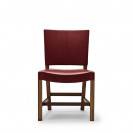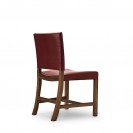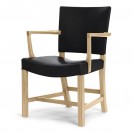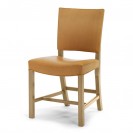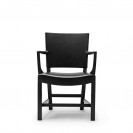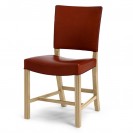KK39490, KK47510, KK37580 & KK37581 THE RED CHAIR
First in the series was the Red Chair in a Large edition (1927), created especially for the lecture hall of the new Danish Museum of Art and Design, and shown at the Danish Pavilion at the 1929 Barcelona International Exposition.
Klint believed that long-existing archetypes could and should inform contemporary design. In developing his Red Chair Series, he studied several English chair designs, including the Chippendale, combining elements to create a new construction with a modern expression and excellent support.
Klint continued to work on the series adding two narrower versions - The Red Chair Small (1928) and The Red Chair Medium (1933) to comfortably fit various dining tables, making The Red Chair available in three different sizes. The series also features a variant with armrests (1930).
The chair is made of solid wood and features leather seat and back.
| About Designer | |
|---|---|
Kaare Klint |
Kaare Klint (1888-1954),
the man behind classics such as the Safari Chair and
the Faaborg Chair, is considered the father of Danish furniture design. For
Kaare Klint, the son of architect Peder Vilhelm Jensen-Klint, exposure to
architecture was a natural part of his early development. However, it was
primarily as a furniture designer that Kaare Klint made his mark on Danish
architecture. Kaare Klint was
born in 1888 in Frederiksberg and designed his first furniture in 1914, for the
Faaborg Museum. From the beginning, Klint's furniture was characterized by
harmony between his choice of form and materials, often inspired by earlier
styles or other cultures. Klint
helped found the Royal Academy of Fine Arts Furniture School in 1923, and was
appointed professor there in 1924. In this role, he inspired and taught a
number of prominent Danish furniture designers, who went on to pave the way for
the golden age of Danish design, from 1945 to 1975. Kaare Klint also
founded the Furniture and Spatial Design Department at the Royal Academy of
Fine Arts, where he employed a teaching method considered radical in his day.
He asked students to construct furniture items from the inside out, based on
thorough pre-analysis. The outward style was less significant; instead, the
focus was on function analysis, choice of materials, and material processing.
Klint's
influence led to a comprehensive renewal of Danish furniture design. He
demanded clear and logical structures, with nothing superficial - only honest,
pure lines, the best materials, and genuine craftsmanship. |




